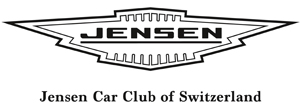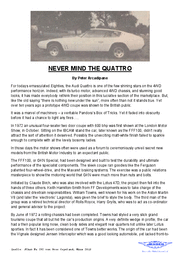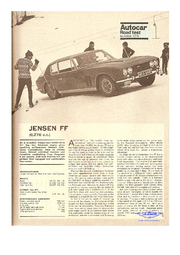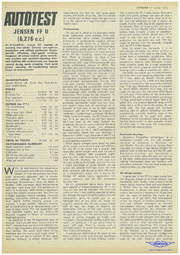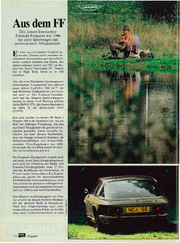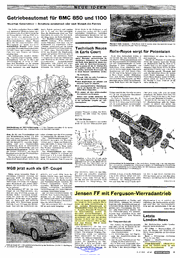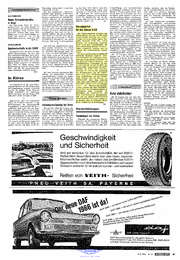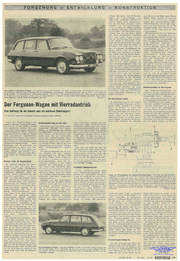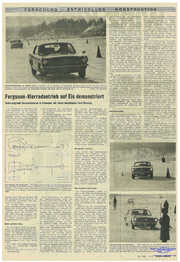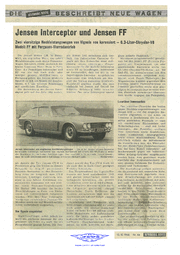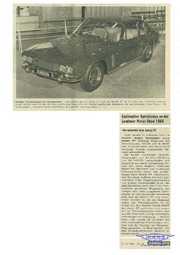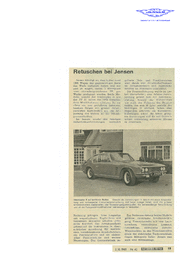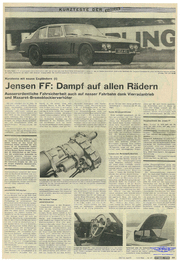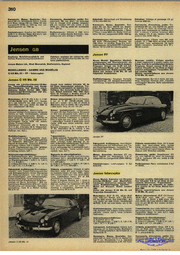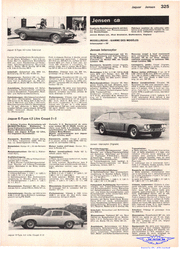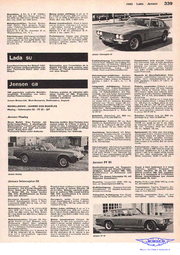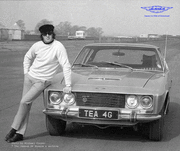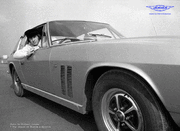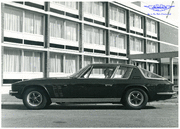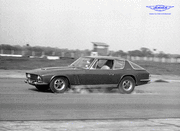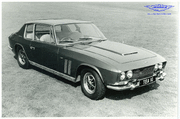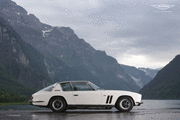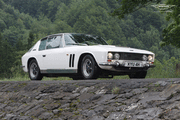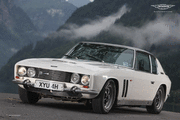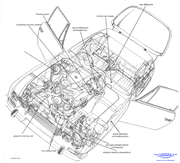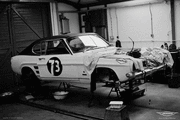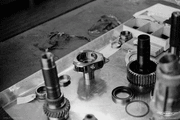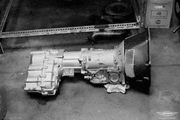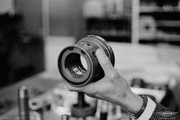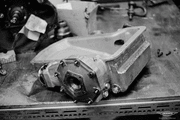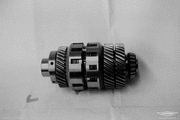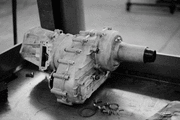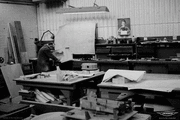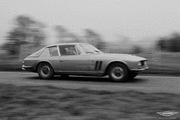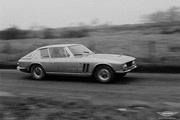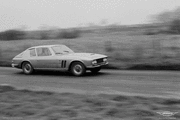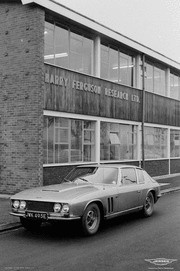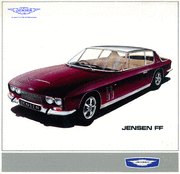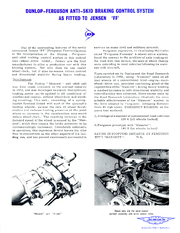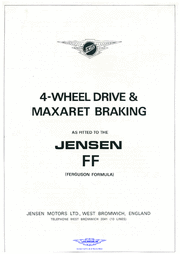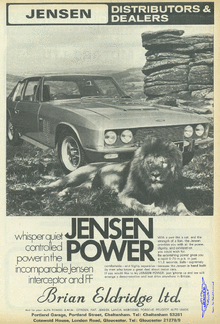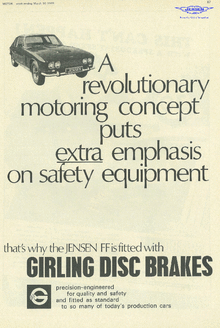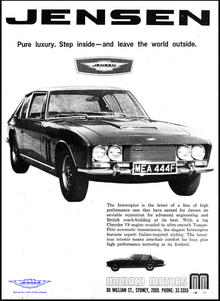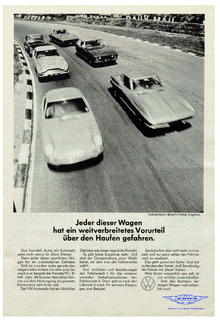Jensen FF
FF (1966-71)
Eine besondere Stellung nimmt der Jensen FF ein. Er war eine Technik Ikone und seiner Zeit weit voraus. Von aussen sah er fast aus wie ein Interceptor, nur die doppelte Reihe mit den Lüftungsschlitzen auf der Seite, der längere Radstand sowie eine anders gestaltete Frontpartie waren Unterscheidungsmerkmale. Unter dem Blech sah es aber anders aus! Die Firma Ferguson lieferte die Basis für den 4 Radantrieb und Maxaret lieferte ein Antiblockiersystem. Und das Ganze geschah 1966! Übrigens wurde bereits vom C-V8 ein Prototyp mit 4-Radantrieb hergestellt. Der Jensen FF war allerdings fast doppelt so teuer wie ein normaler Interceptor und fand dadurch nur eine kleine Käuferschaft.
Vom Jensen FF wurden zwischen September 1966 und Dezember 1969 195 Exemplare produziert, alle rechtsgelenkt. Vom Jensen FF MkII entstanden zwischen Oktober 1969 und August 1971 nochmals 110 rechtsgelenkte Fahrzeuge. Schliesslich gab es zwischen September und Dezember 1971 noch eine Produktion von 15 Jensen FF MkIII .
FF - der 4x4-Pionier mit englischer Technik und italienischem Design von Bruno von Rotz
1965 erregten auf der Motor-Show in London zwei Wagen der Firma Jensen die Aufmerksamkeit des Publikums. Zum einen handelte es sich um den Jensen Interceptor (noch in Cabrioform); der zweite Jensen stellte gar eine technische Weltneuheit dar. Es handelte sich um den Prototyp P66 C-V8 Mk III FF. Dieser Wagen glich, abgesehen von den in den vorderen Kotflügeln eingelassenen Luftauslassgittern, dem Serienmodell C-V8. Als erster Personenwagen der Welt wies er jedoch einen Vierradantrieb nach System Ferguson auf.
"Ferguson Formula"
Schon 1961 hatte Ferguson nach diesem Prinzip einen Formel-1-Rennwagen gebaut, den dann u. a. auch Stirling Moss und Graham Hill an Rennen gefahren hatten. Seither versuchte Ferguson, die Personenwagenindustrie für seine Patente zu erwärmen. Jetzt hatte die Firma Jensen angebissen. Der Jensen FF (Ferguson Formula) wurde auf einem sehr robusten Rohrrahmenchassis aufgebaut, dessen Rohre einen Diameter von 5 Zoll (12,5 cm) hatten (für den Interceptor genügten 4 Zoll).
Allein der Bau des Chassis brauchte seine 44 Arbeitsstunden. Als Motor wurde ein Chrysler-V8-Typ 383 D verwendet, der mit seinem Zylinderinhalt von 6276 cm3 eine Leistung von 330 SAE-PS erbrachte. Diese wurden über ein automatisches Torqueflite-Getriebe auf ein zentrales Differential übertragen, wo die Kräfte zu 37 % auf die vorderen und zu 63 % auf die hinteren Räder verteilt wurden. Dieses Differential besass noch einige zusätzliche Zahnräder, die normalerweise leer mitliefen; drehte jedoch auf Eis oder Schnee ein Rad durch, übernahmen sie die Aufgabe eines Sperrdifferentials.
Dieses System, ganz anders konzipiert als z. B. dasjenige des Jeeps oder Land-Rovers, verlieh dem Auto eine unwahrscheinlich gute Strassenlage. Es war praktisch unmöglich, mit ihm ins Schleudern zu kommen; zusammen mit dem Dunlop-Maxaret-Bremssystem gelang dies nicht einmal bei einer Vollbremsung in Kurvenfahrt...
von Bruno von Rotz, Zwischengas
Artikel
Automobil Revue, Modellübersicht
Bilder
Broschüren
Inserate
Anzahl gebauter Fahrzeuge
| MkI | 1966-69 | 195 | |
| MkII | 1969-71 | 110 | |
| MkIII | 1971 | 15 | (total 3 in die Schweiz) |
| Total 320 | |||
Videos
Reminissenzen Tony Marshall
LHD FF, Crans Montana
I believe there was a mock-up made but I was not aware of this when I was at the factory. Dick Graves told me that the idea had to be abandoned because the Ferguson unit would not rung upside down; as an asymmetrical unit this would mean a new unit and new chassis for an LHD car, the development costs of which were beyond company resources
I remember a rather 'heavy' evening in Crans Montana with some of the Swiss dealers during which many pencil drawings were made on a variety of serviettes proving that a chain link from the steering column across the engine bay bulkhead to a modified steering rack mounting would be a simple thing and, 'Voila!, we 'ave the problem solved!' .
... Someone asked for the price of an Interceptor MkII not long ago, and I can now confirm that in March 1970 the price was £4470 basic, £5838 incl tax. The FF was £5900 and £7705 respectively. Not hard to see why the FF was eventually dropped, despite its tech advantages but the fact that no LHD was available.
One winters night in Crans Montana, after a day of ski bob and an evening of Raclette and suitable beverages, Charlie Bonvin, Jensen dealer in Sion, Edgar Schwyn and myself had drawn up plans for converting rhd FFs to lhd, using a very neat assembly of chains linking the original steering column to a shortened column over on the left side of the firewall. Schimple, tsk? I could never understand the engineering department being reluctant to put this into effect when I returned to the factory!
... Regrettably the 'myth' concerning an LHD version of the FF is hard fact. The problem we had with the FF was due to the Ferguson unit not being able to be run upside down, which it would have had to do if a mirror image conversion was used. With the chassis as designed by Jensen this was the only possibility in order to make room for the steering in an LHD configuration. Believe me, we were well aware that, despite the stiff price, the LHD export market was of considerable value to us and which might well have been sufficient reduce unit cost and prolong the life of it and future models.
With a monocoque chassis and smaller engine block the story is very different, as this Mustang proves. However, still nobody took it up, which I suspect was mainly due to cost and weight penalities.
Could Jensen have designed a better chassis? Most likely yes, but at the time the only affordable way of producing the FF was by converting the Interceptor chassis. While it was not a commercial success in itself, the value of the FF in terms of publicity for the company was enormous, far better than any amount of advertising we could have paid for.
...Anybody know the whereabouts of 127/308? Originally delivered to Edgar Schwyn in August 1971?
Also 127/282 sold in April 1971, via a London dealer, possibly Follett, to a gentleman in Frankfurt. This is known to have been very badly damaged in 1973, and possibly written off. Registration was F-CM-33.
Either of these two could be part of the LHD story.
FF, Edelstahl Dach
It was the FF that was originally scheduled to have a stainless steel roof, not the Interceptor. The first single sheet FF brochure shows a red car with stainless roof, and this had been printed before the decision was made to cancel the idea. Hence the first FF's had silver painted roofs to match the brochure!
... I personally always thought that the Charcoal Grey, Silver Grey roof and Red trim was the best combination we ever did, but obviously not to everyone's taste. To my mind it gave the car a real sense of class.
... Kevin Beattie's idea was to use a stainless steel roof, but early experience with a prototype proved that there were too many problems and the idea was abandoned. By this time, however, the preliminary single page brochure (red car/silver roof) was already being pinted. So that is why all FFs were scheduled to have silver roofs! Strange, but true!
Links

